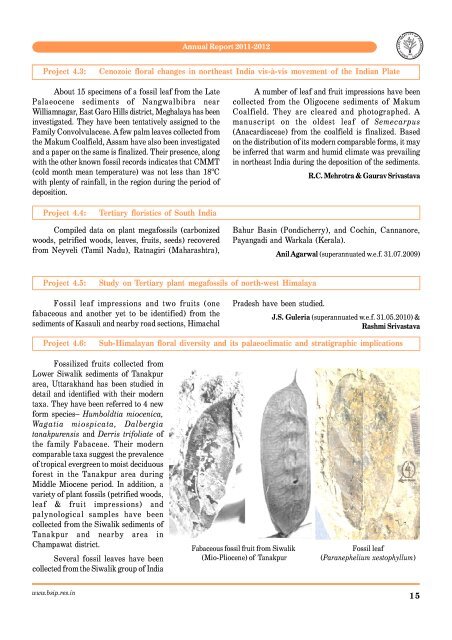Annual Report 2011-2012 - Birbal Sahni Institute of Palaeobotany
Annual Report 2011-2012 - Birbal Sahni Institute of Palaeobotany
Annual Report 2011-2012 - Birbal Sahni Institute of Palaeobotany
Create successful ePaper yourself
Turn your PDF publications into a flip-book with our unique Google optimized e-Paper software.
EBIRBAL SAHNI INSTITUT<br />
Project 4.3:<br />
<strong>Annual</strong> <strong>Report</strong> <strong>2011</strong>-<strong>2012</strong><br />
Cenozoic floral changes in northeast India vis-à-vis movement <strong>of</strong> the Indian Plate<br />
1946<br />
OF PALAEOBOTANY<br />
About 15 specimens <strong>of</strong> a fossil leaf from the Late<br />
Palaeocene sediments <strong>of</strong> Nangwalbibra near<br />
Williamnagar, East Garo Hills district, Meghalaya has been<br />
investigated. They have been tentatively assigned to the<br />
Family Convolvulaceae. A few palm leaves collected from<br />
the Makum Coalfield, Assam have also been investigated<br />
and a paper on the same is finalized. Their presence, along<br />
with the other known fossil records indicates that CMMT<br />
(cold month mean temperature) was not less than 18ºC<br />
with plenty <strong>of</strong> rainfall, in the region during the period <strong>of</strong><br />
deposition.<br />
A number <strong>of</strong> leaf and fruit impressions have been<br />
collected from the Oligocene sediments <strong>of</strong> Makum<br />
Coalfield. They are cleared and photographed. A<br />
manuscript on the oldest leaf <strong>of</strong> Semecarpus<br />
(Anacardiaceae) from the coalfield is finalized. Based<br />
on the distribution <strong>of</strong> its modern comparable forms, it may<br />
be inferred that warm and humid climate was prevailing<br />
in northeast India during the deposition <strong>of</strong> the sediments.<br />
R.C. Mehrotra & Gaurav Srivastava<br />
Project 4.4:<br />
Tertiary floristics <strong>of</strong> South India<br />
Compiled data on plant megafossils (carbonized<br />
woods, petrified woods, leaves, fruits, seeds) recovered<br />
from Neyveli (Tamil Nadu), Ratnagiri (Maharashtra),<br />
Bahur Basin (Pondicherry), and Cochin, Cannanore,<br />
Payangadi and Warkala (Kerala).<br />
Anil Agarwal (superannuated w.e.f. 31.07.2009)<br />
Project 4.5:<br />
Study on Tertiary plant megafossils <strong>of</strong> north-west Himalaya<br />
Fossil leaf impressions and two fruits (one<br />
fabaceous and another yet to be identified) from the<br />
sediments <strong>of</strong> Kasauli and nearby road sections, Himachal<br />
Pradesh have been studied.<br />
J.S. Guleria (superannuated w.e.f. 31.05.2010) &<br />
Rashmi Srivastava<br />
Project 4.6:<br />
Sub-Himalayan floral diversity and its palaeoclimatic and stratigraphic implications<br />
Fossilized fruits collected from<br />
Lower Siwalik sediments <strong>of</strong> Tanakpur<br />
area, Uttarakhand has been studied in<br />
detail and identified with their modern<br />
taxa. They have been referred to 4 new<br />
form species– Humboldtia miocenica,<br />
Wagatia miospicata, Dalbergia<br />
tanakpurensis and Derris trifoliate <strong>of</strong><br />
the family Fabaceae. Their modern<br />
comparable taxa suggest the prevalence<br />
<strong>of</strong> tropical evergreen to moist deciduous<br />
forest in the Tanakpur area during<br />
Middle Miocene period. In addition, a<br />
variety <strong>of</strong> plant fossils (petrified woods,<br />
leaf & fruit impressions) and<br />
palynological samples have been<br />
collected from the Siwalik sediments <strong>of</strong><br />
Tanakpur and nearby area in<br />
Champawat district.<br />
Several fossil leaves have been<br />
collected from the Siwalik group <strong>of</strong> India<br />
Fabaceous fossil fruit from Siwalik<br />
(Mio-Pliocene) <strong>of</strong> Tanakpur<br />
Fossil leaf<br />
(Paranephelium xestophyllum)<br />
www.bsip.res.in<br />
15

















